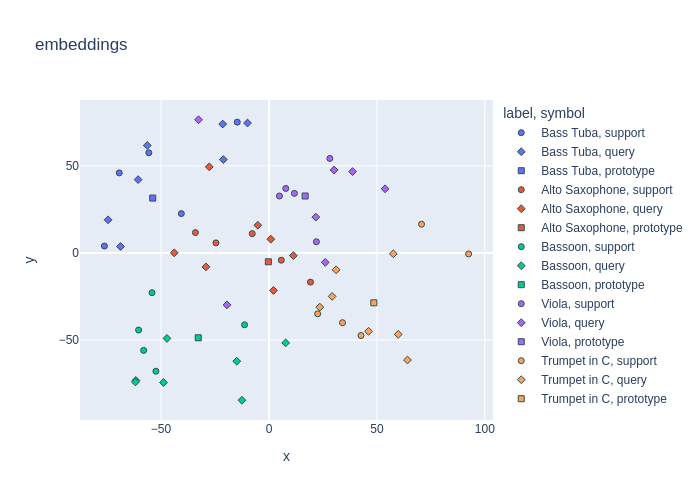Introduction: Few-Shot Learning in PyTorch
Contents
Introduction: Few-Shot Learning in PyTorch#
In this coding tutorial, we will train a musical instrument classifier that is able to categorize novel, unseen classes using few-shot learning.
This tutorial assumes the reader is familiar with PyTorch, as well as the fundamentals of supervised machine learning and music signal processing. The content will focus on introducing the few-shot learning paradigm and how to use it to train an audio classifier for unseen musical instrument classes.

Fig. 7 By the end of this tutorial, you will be able to train a prototypical network for few-shot learning on unseen musical instrument sounds. During the last part of the tutorial, you will be able to plot the embedding space of an episode using T-SNE, and visualize the learned prototypes for a sample test episode.#
We’ll train a Prototypical Network on the TinySOL dataset on a 5-way, 5-shot classification task. Note that in this tutorial, we are using the TinySOL dataset because of its relatively small size and ease of accessibility, thanks to the mirdata library.
However, the same principles can be applied to any dataset. For a bigger challenge, you can try using the MedleyDB dataset, which contains a larger number of instrument classes.
Running the Code#
On your machine#
A repo with ready-to-go code for this tutorial can be found on github. Feel free to use it as a starting point for your own few-shot MIR projects! :)
On Google Colab#
You can also run the code on Google Colab.
If any chapter in this book has an interactive component, you will see a rocket icon on the top right corner of the page. Clicking on the icon will give you the option to run the code on Google Colab.
Google Colab is a cloud-based Jupyter Notebook offered by Google. To access it, click on the rocket icon and select “Colab” from the drop-down menu. This will open a populated Colab notebook in your browser. Colab offers free access to GPUs, which can be used to speed up certain tasks. To use the free GPUs, go to “Edit > Notebook Settings” and select GPU from the Hardware Accelerator drop-down menu.
Requirements#
mirdata
librosa
torch
numpy
torchaudio
torchmetrics
pytorch-lightning
tensorboard
torchvision
sklearn
umap-learn
pandas
plotly
kaleido
Table of Contents#
Here’s a rundown of the topics we’ll cover:
Datasets: We’ll learn how to create a class-conditional dataset for few-shot learning, using the TinySOL dataset.
Episodes: We’ll learn how to construct few-shot learning episodes from a dataset, using an episode dataset.
Models: We’ll learn how to create a Prototypical Network given any backbone model architecture.
Training: We’ll learn how to train our few-shot model using Pytorch Lightning.
Evaluating//Visualizing: We’ll learn how to evaluate our few-shot model on the test set, and the embedding space for some of the test episodes.
